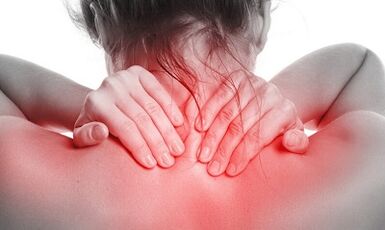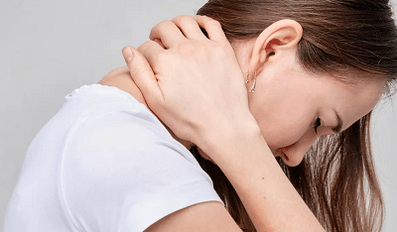
Osteochondrosis is one of the most common pathologies of the muscular system.
A few decades ago, it was believed that this is a problem mainly of older people, but currently, cervical osteochondrosis was "younger".This means that he can deceive young people who concern not only patients but also doctors.
Medicine is actively looking for ways to effectively combat this condition.What is this disease, how does it manifest itself, because of what is developing and how to get rid of it?
DESCRIPTION OF DISEASE
It is a degenerative-district change in the intervertebral discs.The cervical osteochondrosis is associated with their damage, a decrease in their height, as well as damage to the joints, the beads of this area.
In the human life process, vertebrates get tired, the amount of moisture in them is significantly reduced, which is needed for their normal functioning.Moreover, in the joints, bones, the processes of mineral metabolism are violated.All this leads to the fact that they lose strength, the cervical region becomes unstable, its fabrics gain Britch.This, in turn, can be transformed into the fact that the vertebrae has been displaced, often formed intervertebral hernia, the disease of this spine area is progressing.
Osteochondrosis of the cervical region develops in several stages:
- In the first stage, the pulp nucleus is dehydrated - the inner part of the intervertebral disc, which consists of a gelatinous substance and a half -liquid mass (fibers that form connective tissue).Already during this period, the mechanism of bone wing fabrics begins;
- The second stage is characterized by the inaction of the vertebrae, as a result of which there is a sagging of the muscles and ligaments;
- In the third phase, the extension of the disk content becomes pronounced, hernia is formed.At this stage, there is often damage to the uterine muscle and vessels;
- Increased vertebra mobility provokes the body in a response that helps the functionality of this department of the muscular system.The result is the appearance of bone growth on the surface of the vertebrae - osteophytes.Along with these processes, fibrous tissue also grows.These formations wrap this area of the spine, blocking it.
With the development of the disease, this part of the spine is becoming increasingly difficult to perform its functions, and a person experiences tangible discomfort.
Osteochondrosis syndromes and symptoms
The main signs of the disease:
- Pain in the neck, chest, upper spine, shoulders.They can appear on other parts of the body.The appearance of pain is explained by muscle clamps and nerve endings.If there is pain in the thoracic region, maybe cervical osteochondrosis develops.In this case, it can be either harsh and short, but that arises regularly, and not pronounced, but elongated (not withdrawn for several weeks);
- Often the symptom of the disease is headache;
- Dizziness.They, as previous symptoms, manifest for the fact that the artery is squeezed, supplying the brain with nutrients, oxygen.For the same reason, the patient often feels general weakness, quickly tires even with little physical and mental stress;
- The feeling of weakness in the hands.This symptom of cervical osteochondrosis makes itself feel due to the point of nerve endings that are involved in regulating motor activity;
- Reduce (or increase) the sensitivity of the upper limbs.In the advanced stages, the patient may completely stop their movement;
- The stiffness of the upper back, the region of the chest, the presence of attractive sensations;
- Discomfort when performing your head curves.Many patients are unable to fully make their movements.They are usually associated with a crisis that occurs as a result of structural changes in the intervertebral discs;
- Vision of vision, hearing.Osteochondrosis of the cervical spectacles manifests itself due to insufficient blood supply to the brain.They make themselves feel usually in the last stages of the development of the disease.
The pathology is accompanied by a number of syndromes:
- Koreshka.It is associated with pain in the shoulder blade, shoulders and occurs due to nerve clamps in the neck;
- Vertebral.Its main features are headaches, which apply mainly in the occipital, temporary regions;
- Reflex.This syndrome is associated with severe pain, discomfort in the neck.In many patients, these symptoms become more vulnerable in performing head movements.Often they give the chest, shoulders;
- Cardinal.Performed with heart discomfort.Its manifestations are similar to the signs of angina pectoris, and sometimes it is difficult to distinguish these conditions.
The main causes of the development of the disease

Changes associated with age in the body do not go unnoticed by the muscular system.The older the person becomes, the more pronounced the mineral imbalance, the loss of moisture tissue.All this serves as a reason for the development of pathology.
But cervical osteochondrosis can manifest their symptoms among young people, in this case, the onset of the disease is associated with other provocateurs, among whom are the most common: are:
- Improper behavior;
- Excess weight, due to which the spine experiences large loads.In addition, it is usually the cause of a violation of metabolic processes, due to which bone tissue -ocids wear faster;
- Long physical exercise, weight lifting;
- A sedentary lifestyle, due to which a person moves little, stagnant processes are developing;
- Violation of the structure of the spine - congenital or acquired;
- Genetic conditioning;
- Presence of damage to the musculoskeletal system;
- Autoimmune diseases that provoke degeneration of bone meat tissue;
- Frequent stresses, nerve shocks, other negative conditions of the nervous system.
Troubleshooting
If symptoms of the disease appear, you should contact an orthopedic or traumatologist.A patient's complaints may immediately suspect what disease is associated.
But to make an accurate diagnosis, such diagnostic measures are usually described:
- Radiography.Within the framework of this technique, photographs of certain areas are taken to study them in detail.The study allows us to detect formations that are formed during the course of the disease, tissue deformity, disk disputes;
- Magnetic resonance tomography.Thanks to this diagnostic method, it is possible to analyze the condition of the tissue, identify hernia and even decide their size, which is important for determining the stage of development of pathology;
- Calculated tomography.This diagnostic method provides the same information as magnetic resonance therapy, but it is very difficult to determine with its help;
- Electromography.This technique allows you to set the consequences of the course of the disease.Thanks to it, the nerve conductivity is determined.In the case of cervical back osteochondrosis, it is significantly reduced, which serves as one of the signs of pathology.
If there is a violation of blood circulation, an ultrasound examination can be used, which allows you to determine its speed and discover the obstacles that make it difficult if they are.
Methodology of treatment for osteochondrosis of the cervical spine

First of all, therapy is aimed at reducing pain, relieving the patient's condition.The second important purpose of treatment is to prevent the progression of the disease.To solve these problems, an integrated approach is used to include all available medicine measures that can be used for a particular patient.
The main methods of therapy are:
- Physiotherapy;
- Conservative treatment;
- Surgical intervention (if necessary).
Effective additional measures are massage, properly organized tariffs for cervical osteochondrosis, proper nutrition, excluding food that leads to weight gain.In this case, food should satiate the body with useful, mineral substances.It is not necessary to follow the post for life, you just have to compose your diet correctly, adjust the amount of food consumed.
Physiotherapy
This method of treatment of cervical osteochondrosis is most often used as an additional therapeutic mass that is combined with other methods.Its advantage is not only high efficiency, but also security for the whole human body.Is unable to provoke a deterioration of other pathologies in the patient.
Physiotherapeutic procedures are most often used:
- Laser therapy.On the side of the spine, for which the loss was lost, exposure to the flow of light is exposed.Has a healing, anti -inflammatory effect, helps to eliminate pain;
- Electrotherapy.The essence of methodology is the effect on the body with electric fields.Thanks to him, the process of treating the disease is accelerated, pain, unpleasant sensations that accompany it are weakened;
- Magnetotherapy.This method provides for the formation of a bioelectric field that causes the recovery process at the body's own level;
- Shock wave therapy.If cervical osteochondrosis is detected, treatment with this method predicts the supply of an acoustic wave.It contributes to the normalization of metabolic processes, blood flow and recovery processes.This method allows you to eliminate the pain;
- Ultraviolet radiation.The body is informed of high -frequency sounds that have anesthetic, anti -inflammatory effects, contribute to tissue restoration;
- Mudley, balneotherapy(treatment with mineral waters).Both methods include saturation of tissue affected with mineral elements, useful by taking a shower, swimming pools, baths, applying therapeutic agents to the skin.Thanks to these methods, it is possible to eliminate the pain, accelerate the patient's recovery.
Conservative treatment
It mainly includes the use of medicines.
In the context of how cervical osteochondrosis is treated by conservative methods, different groups of medicines that have different effects are used.
Most often is:
- NSAID(non -steroidal anti -inflammatory drugs).Thanks to them, they manage to withstand pain, inflammatory processes that can develop into the tissue, exacerbating the course of the disease.Typically, these medicines are prescribed in the form of gel, ointments;
- Chondroprotectors.These are highly effective medicines created to prevent further development of the disease.Moreover, they contribute to the onset of tissue regeneration processes;
- Analgesic.Medicines of this category are used as anti -inflammatory and painkillers;
- Vasodilative drugs.Thanks to them, it is possible to improve blood flow, which reduces the severity of the pain and the patient's recovery time is reduced;
- Antispasmodics.These drugs contribute to the removal of spasm, significantly reduce nerve sensitivity.Therefore, they have an analgesic effect.
How to treat the disease should only be determined by the doctor.It can combine medicines of different groups to improve their therapeutic effect and its intensity.In some cases, the use of a category of medicines is sufficient.It depends on the specific case.
Surgical treatment
He must always turn to him away.Surgical intervention may be required if there is a threat of causing the central nervous system, spinal brain, large vessels, nerve bundles.All this can lead to very negative consequences.The need for surgery is determined only by the doctor.It also chooses the form of surgical intervention, but they are like this:
- Microdiscectomy.This surgical method is one of the most used.It ensures removal of hernial extension, which crushes on the vessel, nerve endings, muscle tissue located nearby;
- Laminectomy.This is an operation to remove (full or partial) of vertebral arches, ligaments, facial joints;
- Nucleoplasty laser.The technique involves removing part of the pulp core in the affected area by means of a laser;
- Endoscopic surgery.This technique is performed using an endoscope and is assigned to remove hernias;
- Arthrodesis.This type of surgical intervention is used to combine some (often two) beads if they are unstable;
- Transplantation.An operation to plant bone tissue, through which the area between the vertebrae is filled if the intervertebral disc was completely removed.
Complications
It is impossible to leave the disease without attention.The growth of fabrics is fraught with serious consequences, among which:
- Paresis, hands paralysis (one or both);
- Stroke;
- Loss of central nervous system;
- Spinal cord lesion;
- Loss (partial or complete vision), hearing.
In a serious course of the disease and lack of treatment, the patient may even remain disabled.Other organs can also suffer from the disease - the heart, the digestive system, the lungs.
When do you go to the doctor?
It is not worth delaying a visit to the doctor, because without treatment the pathology will progress with certainty.
It is necessary to contact a doctor when they appeared and for several days such symptoms do not withdraw:
- Discomfort;
- Pain in the cervical region;
- Increased fatigue;
- Dizziness, headaches.
To begin with, you can visit the therapist who, with complaints, initial inspection will determine which specialist should be contacted further.
Unique treatment methods
In the fight against this disease, not only the methods listed above are used.In search of a solution to the problem, patients turn to unusual methods, the most popular of which are:
- Manual therapy- a technique that provides the effect on the injured area with the hands.It differs from massage in that, in addition to muscles, joints, bones, vertebrae, discs are worked;
- Hirudotherapy- Fighting the disease with caterpillars, which, with a bite, release biologically active substances in the human body, the main one of which is girudin.It helps to purify blood vessels, improve their condition.Thanks to this, blood flow is normalized and, as a result, the patient's well -being improves;
- Reflexology.People are better known as acupuncture.With its help, it has an effect on biologically active points in order to begin the body's healing processes at the cellular level.
If you decide to turn to such methods of therapy, you should find an experienced, competent specialist.Otherwise, such manipulations can result in a deterioration in the patient's condition if they are performed incorrectly.
Can I contact a massage?

If the patient has no contraindications for him, then it will be very useful.Do not run it if there is a tip of nerve ending.If you overcome the cervical osteochondrosis, you have decided to treat the house with the help of massage, only a professional with high qualifications and great experience should perform it.
Procedures will help normalize blood flow, start the process of tissue regeneration, improve overall well -being, eliminate muscle cramps.But it should be borne in mind that the only way to treat it is not used.
Why is an orthopedic pillow needed?
During sleep, it is important that the head, shoulders, neck are in the right position, comfortable.Soft soft pillows are not always able to provide this, while orthopedic options are created only so that the body gets the right position.
The materials, the shape in which they are made, allow you to relax the cervical beads simultaneously and provide their even location.They are not put under the shoulders (because this leads to the curvature of the spine), but directly under the head.Due to their properties, orthopedic pillows serve not only to prevent various diseases of the cervical region.Using them is an additional measure in their treatment.
Gymnastics for cervical osteochondrosis at home
One of the conditions for improving the condition is to maintain the muscular mass of the diseased region.But physical exercises for cervical osteochondrosis must be compiled correctly so as not to damage the treatment of the disease.They must have an active promotional nature.This means that they need to help strengthen muscles, but at the same time contribute to improving blood flow, eliminating stagnant processes and relieve pain.
Gymnastics for cervical osteochondrosis may include the following exercises:
- Standing in a position in which the legs are parallel to one another and placed on the shoulder width, stretch your head up.At the same time, it is advisable to feel that you, as if someone was drawn up.In this position, describe 5 circles with hours and 5 circles, forgive in the clock.The rotation amplitude should not be large so as not to damage the cervical vertebrae;
- The legs are in the same position in which they were in the previous exercise.with cervical osteochondrosis.Put your hands on your stomach so that a palm tree covers the second.Extend your head forward, as if you draw your nose on the wall.The shoulders should stay in place.In this position, lower your head up and down without throwing it again.During the performance of this exercise with the development of cervical osteochondrosis, you should not suffer discomfort, pain, attractive sensation.Repeat movements in both directions at least 10 times;
- Perform the same manipulation as in the previous paragraph, only get the head back, not forward;
- Sit in a chair, holding the body evenly and simply perform your heads (5-6 in each direction).Do this smoothly, slowly, trying to feel every MM of the cervical region;
- Rest your forehead on your palm.The second must resist, and you try to overcome it.It should not be difficult to be diligent - the pressure should be vulnerable, but not lead to pain.Make manipulation 8-10 times, then take a break within 15-20 seconds.After a break, perform the exercise again, but by changing your hand;
- Raise your shoulders as high as possible, stirring.Hold in this position for about 10 seconds.When you inhale, relax your shoulders and then repeat these actions 8-10 times;
- In a sitting or stretched position, massage the naps, performing neat movements with fingertips.
These exercises for cervical osteochondrosis are recommended to be performed by patients who develop cervical osteochondrosis.
It is necessary to prevent the disease - to eat correctly, to show physical activity (but not traumatic), to monitor your weight.As prevention, special gymnastics should be performed.You can use a set of exercises given in this article.



















